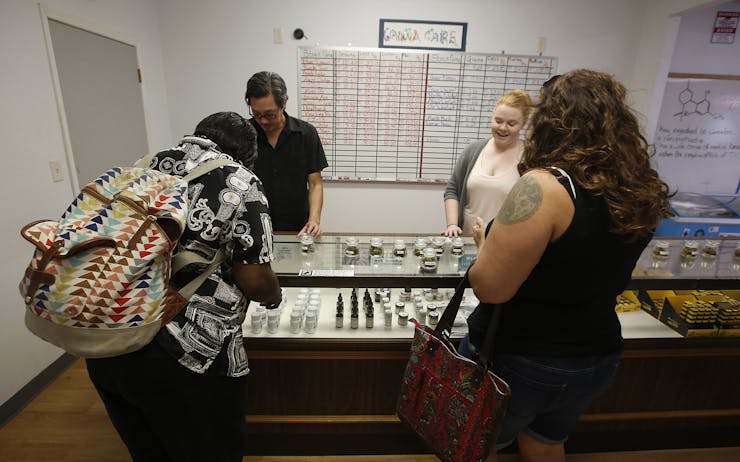By every estimate, California produces and consumes significantly more marijuana than any other state in America. But in much of the state, the multibillion-dollar industry still behaves as an underground enterprise, operating as if it were still illegal—because, for now at least, it still is.
While the right of medical cannabis patients and adults 21 and over to possess and grow cannabis is now enshrined in state law, cities and counties wield retain significant close power control to regulate over how marijuana businesses are regulated locally. It’s authority they haven’t been shy to use: So far, 17 counties—about a third of the state—have banned or severely restricted either commercial cannabis cultivation, retail sales, or both, according to data recently compiled by the California Cannabis Industry Association.
Bans are also in effect in 204 cities, or 42 percent of California’s incorporated communities. In a very few extreme cases, some cities have gone as far as to outlaw or otherwise curtail all marijuana growing, including the six plants all adults are supposed to be allowed to grow at home for personal use under Proposition 64, the state’s successful legalization initiative.
But with commercial adult-use sales set to begin as early as Jan. 1, this trend toward outlawing cannabis is now reversing itself—quickly.
Bans are steadily giving way to regulations. In areas where marijuana businesses are already permitted and licensed, local governments are beginning to relax strict rules, trim permit fees, and lower taxes in an effort to be more competitive than their neighbors.
“In the last six weeks, we’ve seen movement in areas we wouldn’t have expected.”
As for home cultivation, cities are reconsidering all-out bans. The threat of a lawsuit compelled one Northern California town to relent on a proposed ban and allow residents to grow for personal use—just as Prop 64 has always said they could. (Other cities are mulling “inspection” and “permit fees” for home grows, though have yet to collect a dime.)
A look at local cannabis policies reveals the state’s “well-known cultural divide” between progressive coastal cities, conservative inland valleys, and libertarian-leaning foothills, said Hezekiah Allen, executive director of the California Growers Association, a state-level cultivators’ lobby.
Coastal regions tend to be most permissive, with the flatlands and foothills most restrictive. “But in the last six weeks,” Allen told Leafly News, “we’ve seen movement in areas we wouldn’t have expected.”
Rural, agricultural counties—where (unfounded) fears of organized crime and (more reasonable) worries of environmental degradation once fueled blanket bans—are now moving quickly to assist commercial cannabis businesses, outpacing even some traditionally marijuana-producing counties. In other conservative areas, of the type that used to default to bans, lawmakers are holding off on such severe restrictions and exploring ways to make marijuana work.
In perhaps the biggest victory for regulated marijuana to date, voters in Los Angeles, where, four years ago, medical marijuana dispensaries were essentially outlawed by popular vote, the electorate this month voted nearly 3-to-1 to license and regulate marijuana businesses of all kinds.
Why the mass shift? For one thing, most small communities in California don’t write their own laws. That job is passed on to private law firms contracted by cities and counties to act as outside government counsel. Until recently, when the question of marijuana arose, the law firms would reply by sending back a “boilerplate ban” for part-time city councilmembers and rural county supervisors to vote into law. Early last year, the League of California Cities, a local government association, encouraged its members to ban cultivation outright. Many small communities, unsure of what to do, took what seemed like sage advice and banned.
The league has since updated its views, acknowledging a range of workable approaches.
“It’s not bans anymore,” said Nate Bradley, policy director for the California Cannabis Industry Association. “Now they’re saying, ‘How can we make this work? Write us an ordinance that works.’”
The best explanation for this phenomenon is the simplest and most predictable: money.
California may have an economy larger than France, India, and Brazil (and nearly twice that of Russia), but most of the wealth is concentrated in a few select areas, like Silicon Valley and Hollywood. The state, by some estimates, also boasts the nation’s highest poverty rate. In those flatlands and foothills, jobs can be hard to come by.
“We always knew that revenue and job creation would be the carrot on the stick that brought hesitant municipalities to the table.”
After watching cities and counties in Washington and Colorado balance their budgets, repave their streets, and construct enviable civic works projects with marijuana tax revenue, knee-jerk bans are giving way to new efforts to welcome weed. Dreams of cannabis riches are compelling cities to turn abandoned prisons and tire plants into marijuana factories. In one case, a since-abandoned plan to convert a shuttered factory into a cannabis operation would have created a rural California county’s biggest employer.
“We always knew that revenue and job creation would be the carrot on the stick that brought hesitant municipalities to the table,” said marijuana business consultant and longtime legalization activist Mickey Martin, who’s seen clients win licenses in heretofore hostile areas. “While the entire process can often make hardworking and righteous cannabis businesses feel like a cheap whore, at the end of the day, if it results in cannabis becoming more widely accepted, and less people going to jail for producing and selling weed, I will consider it a win.”
The trend began in earnest last year, when desolate desert towns such as Desert Hot Springs turned to marijuana as a source of income.
“I can only imagine what we can do with the tax revenue,” Desert Hot Springs Mayor Scott Matas told the Los Angeles Times. “We’re in need of parks, our roads are dilapidated. All around — our sidewalks, curbs, gutters.”
Even with sky-high taxes and fees—$25 a square foot for grow houses, for example—cannabis companies jumped on board.
Desert Hot Springs was able to propose such high tax rates because few other cities were so welcoming. Now, unless it adjusts, it may find itself moribund again, as marijuana companies flee to friendlier climes.
Just like with any other business, “cities will have to compete,” said Adam Spiker, executive director of the Southern California Coalition, an industry advocacy group.
How far things have come and—how much is still at stake—is evident in Calaveras County, a rural, sparsely populated stretch of foothills and giant Sequoias in Gold Country best known (if at all) for being the setting of a famous Mark Twain short story.
The foothills are Donald Trump territory; Calaveras, where Trump beat Hillary Clinton by a nearly 2-to-1 margin, is one link in a north-south chain of seven counties where conservative views rule. Voters here rejected Proposition 64, which legalized adult-use cannabis, while also rejecting a gun control measure and a proposed ban on the death penalty.
At the same time, Calaveras voters approved slapping a tax on marijuana cultivation. That tax could raise $10 million a year, a princely sum in a county where the median income is one-third below the state average. Given the chance to ban commercial marijuana cultivation marijuana in January, county supervisors balked at the very last second. The question will now be decided by voters in a special election in May.
“All we are asking for is good government,” said former Calaveras County Supervisor Thomas Tryon.
Tryon is a Libertarian who believes former President Barack Obama is a Marxist. Tryon also has designs on becoming a commercial cannabis farmer.
“Frankly,” he said, “a ban is not good governance at all.”





